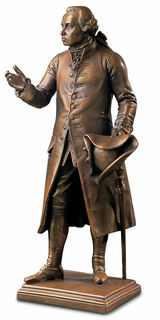Sculpture "Immanuel Kant", version in bonded bronze
Sculpture "Immanuel Kant", version in bonded bronze
Quick info
museum replica | bonded bronze | handmade | patinated | height 55 cm
Detailed description
Sculpture "Immanuel Kant", version in bonded bronze
Schadow's pupil Christian Daniel Rauch was responsible for this era-defining work by the versatile, great German philosopher (1855). Just like Kant's transcendental-idealistic ideas, this statue has survived the ages.
Original: National Museums in Berlin - Prussian Cultural Heritage.
Total height 55 cm, base size 18.3 x 16 cm. Version in bonded bronze. Polymer ars mundi museum replica cast by hand with fine bronze patina.
The term refers to the art movements of ancient, mostly Greek models.
According to the current understanding, classicism is the period between 1750 and 1840 when the late Baroque was gradually replaced by classically orientated art. The great explorations of Greek art and architecture at that time awakened a true enthusiasm for antique models. The Glyptothek in Munich, the Panthéon in Paris, The New Guard House (Neue Wache) and the Brandenburg Gate in Berlin are just a few examples of the revived classical style.
The leaders of the statuary art were Antonio Canova, Bertel Thorvaldsen and in Germany Johann Gottfried Schadow and Christian Daniel Rauch.
In painting, the outstanding representatives of this style are Jaques-Louis David or Jean-Auguste-Dominique Ingres.
Bronze powder is polymer-bonded. Special polishing and patination techniques give the surface of the casting an appearance similar to the bronze.
A true-to-the-original reproduction of an artwork in the same size and with the best possible material and colour uniformity.
The mould is usually taken directly from the original so that the replication reproduces even the finest details. After casting the replication, using the most appropriate method, the surface is polished, patinated, gilded or painted according to the original.
A replication of ars mundi is a recognizable copy of the original.
A plastic work of sculptural art made of wood, stone, ivory, bronze or other metals.
While sculptures from wood, ivory or stone are made directly from the block of material, in bronze casting a working model is prepared at first. Usually, it is made of clay or other easily mouldable materials.
The prime time of sculpture after the Greek and Roman antiquity was the Renaissance. Impressionism gave a new impulse to the sculptural arts. Contemporary artists such as Jorg Immendorf, Andora, and Markus Lupertz also enriched sculptures with outstanding works.


